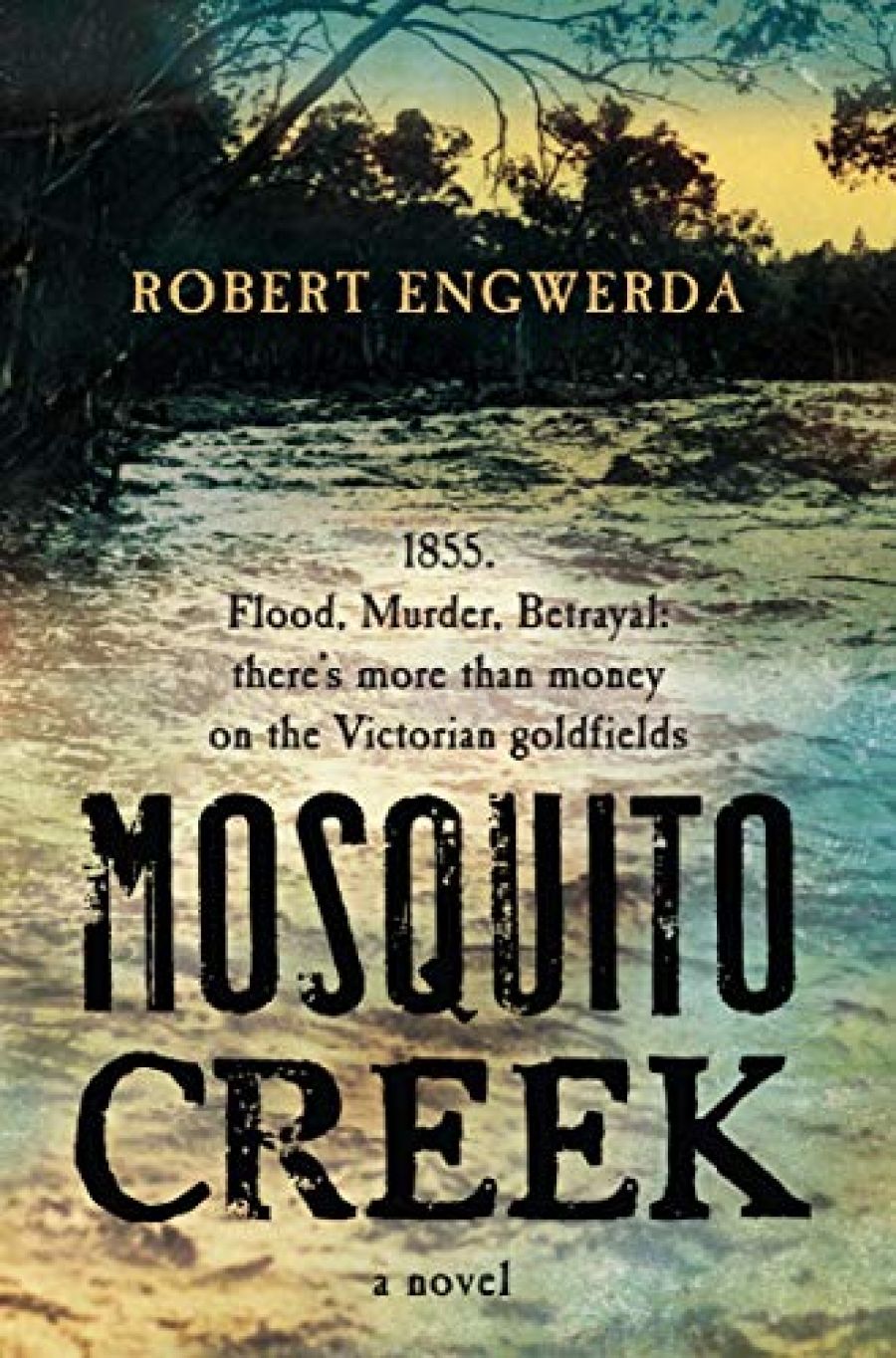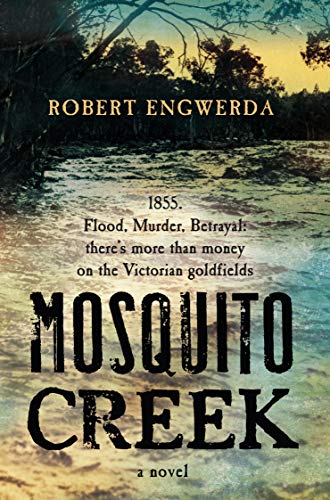
- Free Article: No
- Contents Category: Fiction
- Review Article: Yes
- Article Title: Flash forward
- Online Only: No
- Custom Highlight Text:
A flooding river in the Victorian goldfields of the late 1890s dominates Robert Engwerda’s second novel, Mosquito Creek. Hidden undercurrents, old secrets and the threat of imminent death shadow this compelling narrative. Engwerda strives for a mood of anticipation, which is heightened by longing and brutality. The story follows events in the lives of several key inhabitants of a remote township, each struggling to cope with the rising flood. A bureaucrat commissions a boat to be built in order to rescue marooned miners; a policeman tries to maintain order in the town while he tries to solve a murder; a woman dreams of escape from a violent father. Linking these characters’ stories is the ambiguous presence of Phillip Oriente, the murder victim, who appears almost entirely through a series of second-hand accounts.
- Book 1 Title: Mosquito creek
- Book 1 Biblio: Penguin, $32 pb, 338 pp
- Book 1 Cover Small (400 x 600):

Engwerda’s novel offers a gripping and multifaceted exploration of the influences of the past. He has visited some of these themes before, in a very different context. His first novel, Backwaters, longlisted for the 2005 Miles Franklin Award, also contained themes such as the backwash of memory and uncertain loss, in a more modern setting. A teacher and writer, the Melbourne-based novelist, born in the Netherlands, has also published educational works dealing with Australian history. Mosquito Creek is written as a taut narrative, reminiscent of the atmosphere and motifs of Victorian sensation fiction. Mysterious death, journeys of escape, the pursuit of clues to solve a case, and disappearing objects of intense personal value are all features of the sensation genre, a precursor to the modern detective thriller. Engwerda uses these elements to evoke the texture of the period, as the central characters of this historical thriller each wrestle with their burdens in different ways.
At first reading it is the detailed scene-setting that seems the most engaging aspect of this novel. Engwerda’s descriptions of the muddied goldfields landscape, gutted by mine shafts, the pressure of the rising river and his deft application of historical allusion to tell a story are all impressive. His characters are most alive in the material details that convey their lives and emotions. Throughout the novel, Commissioner Stanfield displays both reckless hubris and unresolved yearning for family acceptance. This is most effectively captured when he unpacks damp storeroom trunks. Stanfield discovers abandoned white shirts that ‘bloomed with wildflowers of gunpowdery mould’ and books with ‘pages like rotten fruit’, and lingers over smooth, hard pieces of rock once fought over and ‘passed from hand to hand’ that revive painful memories of a lost brother.
More importantly, this search reveals a secret: the small ornamental box which once contained a piece of Lord Nelson’s blood-stained uniform, which Stanfield had stolen from his father and ‘smuggled into his luggage the day he sailed’ for Australia. For Stanfield, the relic holds a disturbing significance as his father’s icon of English pride and as the measure to which he can never rise. In the context of the novel, this small lost object also comes to represent the fading significance of a country left behind.
Engwerda’s vision of Victorian goldfields life is striking for its grittiness and drama. The novel brings together historical elements that convey that harsh time and the clash between men and women struggling for power, wealth or survival. In many ways, this is a book about masculinity. The area commissioner Stanfield’s unresolved conflict with his father is contrasted with policeman Kennedy’s carefully judged independence. The scenes that take place among the flood-trapped miners enact a visceral and potentially fatal conflict over dwindling food supplies. The single female character in this story, Sarah Delaney, is another victim of paternal violence, but her youth and spirit suggest the possibility of hope.
Engwerda’s cinematic eye for dynamic narrative and scenic drama isn’t quite matched by the dialogue, which, while intended to convey the laconicism of contemporary speech, can be boringly clichéd. Its virtue, however, is its use as an economical way of driving the story. In turn, the narrative is mostly well balanced as it shifts between three major strands: Stanfield’s ambition, Niall Kennedy’s determination and the small group of increasingly desperate miners isolated by burgeoning floodwater.
Some readers may find that, while the interweaving of the narrative is intriguing, the strange tale of its central character, Phillip Oriente, never feels complete. The reader is left to piece together the various accounts of his actions, in which he is portrayed as blackmailer, drunken digger, lovelorn wanderer, canny tracker and victim of savage attack. The threads of his story and his unusual name, with its various implications of difference, are never fully resolved. Instead, Oriente’s story serves as a framework for the other characters and their intertwined stories. The second-hand tales of his remarks and advice to the other miners offer an understated alternate perspective on the motivations of the commissioner and his men. When we do encounter him face to face, Oriente brings evidence to light which draws the elements of narrative together in a surprising resolution to this powerful story.


Comments powered by CComment